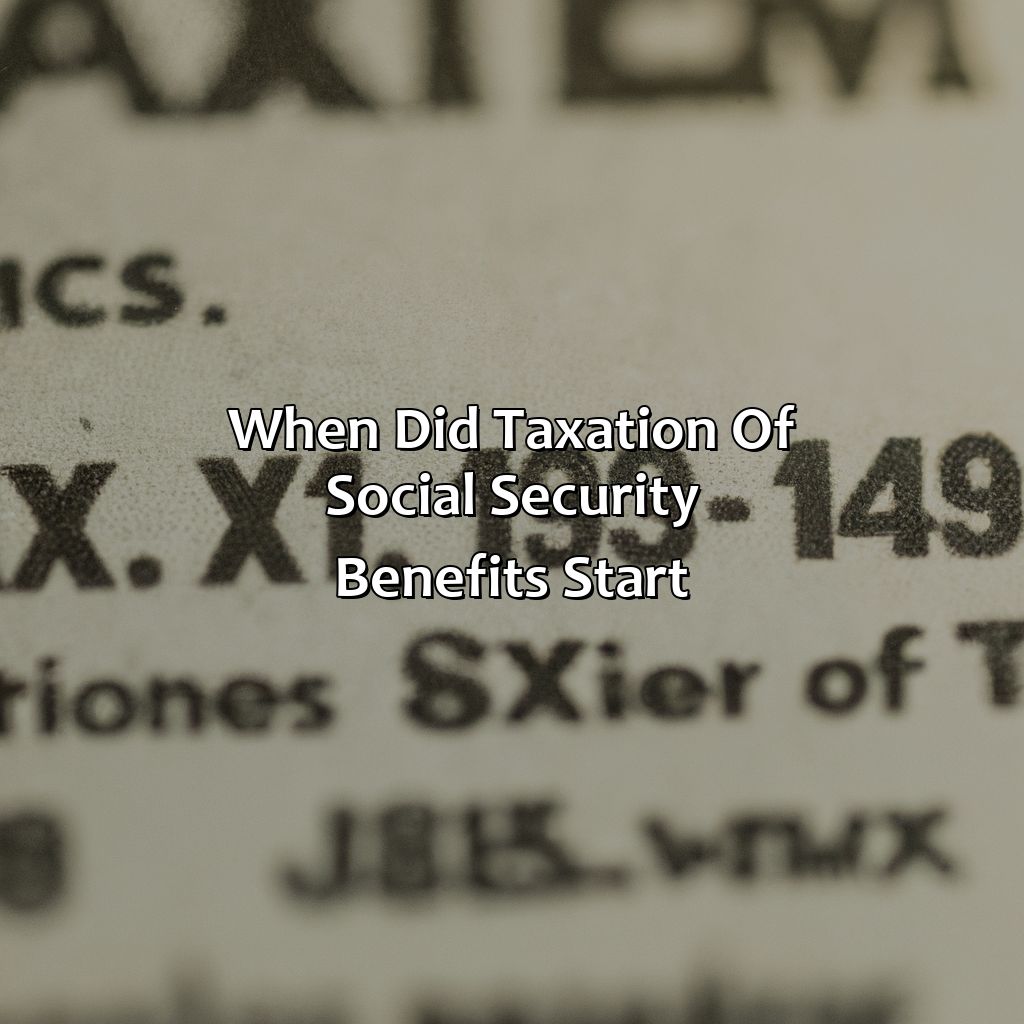What Year Did They Start Taxing Social Security?
Key Takeaway:
- The taxation of Social Security benefits began in 1984, under the Social Security Amendments of 1983. These amendments were made to address the long-term funding of the Social Security program.
- Under current rules, up to 85% of Social Security benefits can be subject to income tax, depending on the recipient’s combined income. The thresholds for taxation are based on a formula that includes adjusted gross income, nontaxable interest, and half of Social Security benefits.
- The taxation of Social Security benefits has a significant impact on recipients, particularly those with higher levels of income. However, it also helps ensure the long-term stability of the Social Security program and the availability of benefits for future generations.
Are you wondering when taxes were first imposed on Social Security? Unravel the mystery in this article to find your answer! Discover how taxation rules have evolved over the years and how it impacts you. You won’t want to miss it!
History of Social Security
Grasp the past of social security, particularly “The Social Security Act of 1935” and “Amendments to the Social Security Act“. This will help you understand when the levy of social security taxes began. See how it has progressed through the years to become what we now know as the system.

Image credits: retiregenz.com by Harry Duncun
The Social Security Act of 1935
The groundbreaking legislation ratified in 1935 was a vital social welfare initiative that established the Social Security Program in America. The program aimed to provide retirement benefits and protection against disabilities for registered beneficiaries. Through an extensive revenue mobilization system, the Act successfully ensures dignified living standards for retired seniors.
To fund this program, a mandatory pay-as-you-go deduction from workers’ wages was instituted along with an equal contribution from employers. Additionally, taxation on retirees’ benefit payments and interest income from surplus revenues are levied on eligible taxpayers by the Internal Revenue Service (IRS) since 1984.
The SS program has undergone significant growth throughout its lifetime through various amendments. In 1946, survivors’ benefits were introduced, while disability insurance came into effect in 1958. With time it grew more inclusive to people of every gender and race.
The Social Security Program has been instrumental in enabling millions of Americans to retire comfortably and remain independent as they age. When severe financial catastrophes like the Great Depression occur or personal tragedies such as medical emergencies arise, social security’s safety net is essential.
Why fix what ain’t broke? Unless, of course, you’re the Social Security Act.
Amendments to the Social Security Act
The Social Security Act has undergone significant revisions over the years, with numerous amendments enacted to enhance its effectiveness. These adjustments have resulted in a complex web of laws that affect both employers and employees. Such alterations cover extensive areas related to retirement provisions, disability support, and insurance for the elderly. To ensure the safety of beneficiaries, several modifications have been made through the years pertaining to funding, eligibility criteria and the benefits package received by individuals.
One such amendment was the inclusion of taxation on social security benefits starting from 1983. This modification aimed to bolster the financial stability of Social Security programs for future retirees while reducing deficits in their finances. Workers earning above specified thresholds had a portion of their Social Security income subjected to payroll taxes hence increasing their contribution towards its sustenance. Today, these levies make up a significant portion of what funds the program.
Despite various improvements made over the years, more changes are expected as time goes by due to demographic shifts in population and technological advancements among other factors influencing public opinion on social security policies. It is important to stay informed about possible reforms that may impact your financial wellbeing and plan accordingly.
Be sure to stay knowledgeable on current legislative efforts related to social security reforms; doing so can help one prepare for any potential changes regarding benefits or eligibility criteria in life or family members’ lives who will depend on federal assistance later in life.
Looks like even social security benefits aren’t safe from the taxman’s grasp.
Taxation of Social Security Benefits
For help with taxation of social security benefits, take a look at the 1983 Amendments. Look into the thresholds and rates for taxation as well. Understanding these details can benefit you financially. So, learn the nuances!

Image credits: retiregenz.com by Yuval Woodhock
The 1983 Amendments
The 1983 Social Security Amendments introduced the taxation of social security benefits to support the program’s long-term financial stability. This decision came after several years of debate about how to address the program’s impending insolvency.
To implement this change, Congress passed legislation that would tax a portion of social security benefits for individuals whose income exceeded a certain threshold. Initially, only 50% of an individual’s benefits were subject to taxation if they earned more than $25,000 in annual income. However, subsequent changes increased the taxable percentage and lowered the income threshold.
These amendments were a controversial but necessary step in ensuring the long-term viability of the social security program. While some argue that taxing benefits disproportionately affects low-income seniors, supporters maintain that it is a fair way to reduce overall program costs while still providing critical support for retirees.
As such, for those who are subject to this taxation, strategic financial planning can help mitigate its impact. Options include delaying retirement or reducing taxable income by modifying investment strategies or utilizing tax-advantaged accounts.
In summary, while initially met with resistance and controversy, the 1983 Social Security Amendments were implemented as a prudent measure to ensure the future sustainability of the social security program. By understanding its implications and implementing sound financial planning practices, individuals can continue to benefit from this important safety net in their retirement years.
Getting taxed on your social security benefits is like getting a participation trophy for making it to retirement.
Thresholds and Rates for Taxation
When it comes to Social Security benefits, certain thresholds and rates apply for taxation purposes. A person’s income and filing status are used to determine whether or not their social security benefits will be taxed.
Below is a table outlining the current thresholds and rates for taxation of Social Security Benefits:
| Filing Status | Provisional Income* | Taxation of Benefits |
|---|---|---|
| Single, Head of Household, Qualifying Widow(er) | $25,000 to $34,000 | Up to 50% taxable |
| Single, Head of Household, Qualifying Widow(er) | Over $34,000 | Up to 85% taxable |
| Married Filing Jointly | $32,000 to $44,000 | Up to 50% taxable |
| Married Filing Jointly | Over $44,000 | Up to 85% taxable |
*Provisional income = adjusted gross income + nontaxable interest + half of Social Security benefits.
It’s important to note that these thresholds and rates can change from year to year based on inflation adjustments made by the government. Additionally, only those with provisional incomes above the threshold amounts will have a portion of their Social Security benefits taxed.
There is a misconception that Social Security benefits have always been tax-free. However, this isn’t true. In fact, in 1983 under President Regan’s administration The United States Government passed legislation that allowed them that allows up up to 50 percent of people’s Social Security income subjecto taxes if their combined income is about a present limit (source: AARP).
Uncle Sam started taxing social security benefits in 1984, proving that death and taxes really are the only guarantees in life.
When Did Taxation of Social Security Benefits Start?
The Taxation of Social Security Benefits began in 1984 when the Social Security Amendments were passed by Congress. The law mandated that a proportion of social security benefits would be taxable, based on income levels. The taxation applies to individuals with a combined income exceeding a specific threshold. The thresholds are adjusted annually to account for inflation.
Additionally, the taxation of social security has become a significant source of revenue for the country’s government. Therefore, it has encouraged policymakers to consider the program’s financial solvency through taxation policies.
One crucial aspect to note is that not all retirees are subject to social security taxation. The taxation only affects individuals whose income meets a specified limit, considering their other incomes, including investments and retirement accounts. This means that taxes may be levied on up to 85% of an individual’s social security benefits, rendering it taxable.
Interestingly, the taxation of social security benefits has had a varying impact on retirees’ lives, depending on their financial situations. Retirees who have other sources of income beyond social security benefits may be required to part with additional taxes. Those who rely solely on social security for their income may not be affected much, if at all.

Image credits: retiregenz.com by Harry Duncun
Impact of Taxation on Social Security Recipients
Social Security recipients are greatly impacted by taxation. The taxes on Social Security can significantly reduce the amount of income available to senior citizens and others who rely on it for financial stability. Income tax must be paid on benefits if total income, including Social Security income, exceeds a specific amount. This means that recipients must pay higher taxes and receive less money, ultimately affecting their quality of life. Additionally, the taxation begins when the recipient’s income goes above a specific threshold. Understanding the impact of taxation on Social Security recipients is crucial for financial planning and security.
Interestingly, in 1983, the Social Security Amendments of 1983 were passed, which introduced taxation on Social Security benefits. This was part of the solution to fix the financial shortfall in the Social Security program. The amendments introduced a percentage of Social Security income that is subject to taxation, and the threshold for taxation was set. This change in policy has had a significant impact on Social Security recipients, and it remains an important consideration for anyone planning retirement.
According to the Social Security Administration, the first year Social Security taxes were collected was 1937 when the Social Security Act became law. This marked a significant moment in history as it paved the way for social welfare programs in the United States. Today, the program is funded by taxes from employees, employers, and self-employed individuals who contribute a percentage of their earnings. The program provides critical financial assistance to millions of Americans, and it remains an essential program for social welfare.

Image credits: retiregenz.com by Joel Arnold
Five Facts About When Social Security Taxation Began:
- ✅ Social Security taxation began in 1937, as part of the original Social Security Act. (Source: Social Security Administration)
- ✅ Only the employee portion of Social Security taxes was originally collected, with the employer share introduced in 1951. (Source: Investopedia)
- ✅ The Social Security tax rate has increased from 1% in 1937 to 12.4% today. (Source: The Balance)
- ✅ The Social Security tax is only applied to a certain amount of income each year, called the Social Security wage base. (Source: Forbes)
- ✅ In 2021, the Social Security wage base is $142,800, meaning all income above this amount is not subject to Social Security taxes. (Source: Internal Revenue Service)
FAQs about What Year Did They Start Taxing Social Security?
What year did they start taxing social security?
They started taxing social security in 1983.
Why did they start taxing social security?
The government needed to find a way to generate more revenue in order to keep Social Security viable in the long term. Taxation of benefits was seen as a way to bolster the financial health of the program.
Who is affected by the tax on social security?
Anyone who receives social security benefits and has a certain level of income may be subject to taxation. The exact level of income that triggers the tax depends on the person’s filing status.
How much of social security benefits are subject to taxation?
Up to 85% of a person’s social security benefits may be subject to taxation, depending on their income level.
Can you avoid paying taxes on social security benefits?
It may be possible to avoid or reduce taxes on your social security benefits by managing your income in retirement. Strategies such as delaying social security and withdrawing money from tax-free accounts can help reduce your taxable income and lower your tax bill.
Are social security taxes the same as taxes on social security benefits?
No, they are not the same. Social security taxes are deductions from a worker’s paycheck that go towards funding the program. Taxes on social security benefits are levied on a portion of the benefits received by certain taxpayers.
